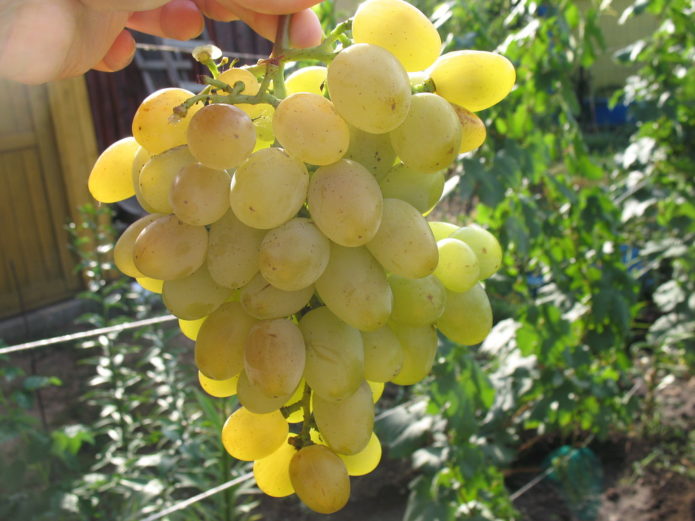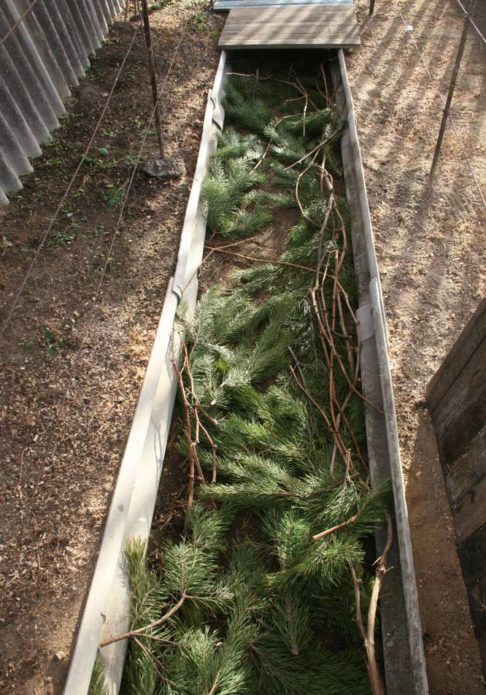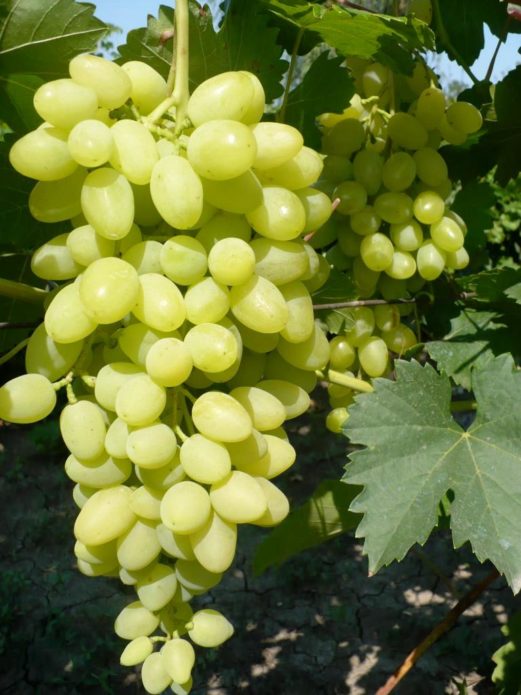Grapes of the Long-awaited variety contain almost no seeds, therefore it is sometimes called a raisin variety. But the Long-awaited one differs from traditional raisins by its very large fruits. This grape, fully consistent with its name, is a true find for both professionals and ordinary summer residents in most climatic regions.
Content
Breeding history, description and characteristics of the long-awaited grape variety
The Long-awaited grape is a young variety bred in the current century by an amateur breeder V.N.Krainov. This is a "private" breeder who has never worked in scientific organizations, but has created a lot of worthy grape varieties on his site in Novocherkassk. On the banks of the Tuzla River, he was engaged in viticulture from a young age, and in the mid-1980s. I began to test myself for the possibility of obtaining new varieties, and it worked!
Since there were not very favorable conditions for grapes on the site, the varieties created by him (and there are more than forty of them) are distinguished by increased resistance to the vagaries of the weather and most diseases. The first hybrid, named NiZina, was obtained in 1998. He is now adequately represented in many vineyards of the country. Like the first variety bred by VN Krainov, all his developments, including the Long-awaited one, have very large, sometimes gigantic berries; its varieties receive only positive characteristics from specialists.
Many grape varieties are bred on the basis of hybridization with delicious berries of Radiant Kishmish and Talisman. From them came the Long-awaited One, who took early maturity and resistance to adverse conditions from the Talisman, and from the Radiant Kishmish - a unique nutmeg taste. Long-awaited - a table variety, famous for high yields of early ripening and the ability to grow in harsh weather conditions. It is quite suitable for growing in summer cottages.

The talisman is widely used in breeding work, he conveyed his positive qualities to the Long-awaited
The variety requires a relatively small area of nutrition, although it grows in the form of a rather large bush. The bushes, planted at distances of one and a half meters from each other, are strongly intertwined with root systems, but at the same time do not interfere with joint normal growth and fruiting. At the same time, for a small family, two bushes are not really needed. The yield of the Long-awaited is quite sufficient for the use of berries for a long time, and he does not need pollinating varieties: the flowers of this grape are bisexual.
The variety responds normally to grafting of its cuttings onto bushes of other varieties. On the other hand, he himself can act as a good stock. Therefore, in small areas, you can have one bush of grapes, bearing fruit of different varieties.The long-awaited one multiplies well by cuttings, its bushes grow well, regardless of whether the cuttings are grafted onto another variety or acted as a starting material for growing a seedling.
Even in a climatic zone characterized by a short summer period, the vine manages to ripen almost 100% of its length. Frost resistance is common for most modern varieties: grapes can withstand temperatures up to -23 ° C without shelter. The variety is poorly protected from oidium, tolerant to other diseases, and is not affected by ticks. Gives normal yields in the third year after planting.
It is not quite clear why, but the berries of the Long-awaited one hardly touch the wasps.
The long-awaited fruit can successfully bear fruit even with a lack of natural sunlight, as a result of which it is recommended for cultivation in the North-West region, where short days quickly come after white nights. From budding to full ripening of the berries, it takes from 105 to 120 days, that is, the variety can be attributed to the superearly varieties of grapes. The first berries in the middle lane can be tasted at the beginning of August, and by the end of the month the harvest is ready in full. It is not very high: from one adult bush you can get up to 10 kg of berries.
The bunches are cone-shaped, large: on average they weigh about 800 g, the record holders reach a mass of 1.5 kg. Already in the second year of fruiting, they are completely complete both in size and quality of berries, which are not very tightly packed. The crop transportability is very good.
The berries are beautiful, oblong-nipple-shaped, white at the beginning of ripening, but then becoming transparent and almost amber in color. They reach 35 mm in length, weigh up to 12 g, are covered with a skin of medium thickness, which does not interfere with the use of fresh crops. The pulp is sweet and sour, fleshy, the juice contains up to 20% sugar and about 8 g / l of a mixture of organic acids. The taste is pleasant, but without peculiarities, with a slight astringency. Seeds are present only in some fruits, but they are, although not large, no more than 2 pieces per berry. Moreover, in the composition of each bunch there can be berries both without seeds, and with them, and it is impossible to distinguish them outwardly.
The fruits keep well both on the bushes and in the harvested state, in normal weather they do not crack, but in the case of abnormally high air humidity, slight cracking of the berries is possible. When oversaturated with moisture, they can not only crack, but also rot or come off the bunches. The combination of indicators of sugar content, total acidity and pleasant taste allows us to consider the Long-awaited variety of universal use.
Video: harvest of the Long-awaited on the bushes
Features of planting and growing grape varieties Long-awaited
Agrotechnics of the Long-awaited one is quite common for a covering variety of early table grapes; its planting and cultivation does not imply any surprises. It can be grafted with a cuttings into a stem or crown of most other varieties, or a seedling can be grown from a lignified cuttings and then planted in the usual way. It is better to do this in the sunniest area, sheltered from the action of piercing winds, especially in the northern direction. At the same time, the variety can grow normally in partial shade, so tall fruit trees such as pear or apple trees can be used to protect from the winds.
On any type of soil, except for clearly swampy, the Long-awaited one will give full yields, but it feels best on light soils with a high content of nutrients. The variety easily tolerates drought and requires a high amount of water only during the period of intensive fruit growth. On the contrary, waterlogging of the soil is painful.
The planting of this grape has no peculiarities and is well understood by any grower. It is better to plant grapes in April, except in the southern regions, where the October option is also possible.Since the roots will quickly spread over a considerable distance, it is necessary to dig up a plot of at least 3 x 3 meters in advance with fertilizers, and only after that prepare the planting hole. It should be the usual size for grapes, about 80 cm in all dimensions, and contain drainage material at the bottom, then a mixture of soil with fertilizers, and in the upper third - clean fertile soil.
When planting in April, even those two buds that are left on the surface are recommended to be temporarily covered with soil. The planted bush is well watered, and if not a trellis, then at least a strong stake is prepared in advance for a garter of a rapidly growing main shoot in the first year of life of the future bush. In addition, in arid regions and in the case of heavy soil, it is advisable to equip the irrigation pipe in advance by placing it vertically so that it reaches the depth of the future roots of the seedling.
Frequent watering is required only in the first year, then their frequency decreases, and fruiting bushes are watered during the active growth of berries, before winter and in case of abnormal drought. The Long-awaited one responds to feeding with approval, but it is better to limit yourself to compost and wood ash, burying them in shallow holes in the early spring in the amount of a bucket and a liter, respectively. Before flowering and immediately after it, foliar dressing with diluted solutions of complex fertilizers is desirable, strictly according to the instructions for the preparation.
The most important event is qualified pruning. In the spring, only non-wintered shoots are cut out, and the main pruning should be done after autumn leaf fall. But, in addition to the main pruning, throughout the growing season, weak, clearly superfluous young shoots that thicken the bush should be broken out. In autumn, 7-10 buds are left on the Long-awaited bushes on each shoot, but you can cut it shorter, depending on the chosen method of forming the bush: in the variety under consideration, it can withstand a total load of 20-25 shoots.
It is also necessary to normalize the crop, no matter how pitiful it is to cut off the already incipient bunches. They are heavy, large, and the whole bush does not stretch: at least the berries may not fully ripen, and in the worst case, the shoots may even break. They must be periodically tied firmly to the trellises.
Treating the vines in early spring with a solution of ferrous sulfate or Bordeaux liquid almost solves the problem of protection against fungal diseases, but in the event of an unfavorable summer, it may be necessary to apply more severe treatments.
In the second half of autumn (specific dates depend on the region), the vines are removed from the trellises and an easy shelter is arranged for the winter. It doesn't have to be very serious, in most areas spunbond or pine branches are sufficient. Moreover, a slight freezing of the buds is not terrible for the Long-awaited and can only slightly delay the flowering and ripening of the crop.

Thorough shelter The long-awaited one is required only in a harsh climate, but a good owner equips him according to all the rules
Advantages and disadvantages of the variety in comparison with similar
The long-awaited, undoubtedly one of the best modern grapes in its category. Probably, it is inferior to the taste of berries, for example, Tason, in terms of ripening even Libya, but these varieties necessarily have seeds, and they only "meet" in the Long-awaited one. Of course, the variety is not ideal, but according to the totality of indicators, it can be classified as one of the best early varieties of large-fruited table grapes. If you add up its merits and relative demerits, the first list is much longer than the second. So, the obvious advantages of the variety can be considered:
- very early maturation;
- undemanding to the presence of pollinators;
- large clusters and individual berries in them;
- excellent appearance of bunches;
- good transportability and duration of storage of the crop;
- almost complete absence of seeds, as a result of which the variety is often considered kishmish;
- good yield;
- weak susceptibility to wasps attacks;
- good frost resistance;
- guaranteed ripeness of shoots;
- compatibility with most rootstocks and scions.
To some extent, the disadvantages of the variety include:
- average disease resistance;
- the possibility of crop damage in case of prolonged rains;
- although rare, but unexpected presence of seeds in individual berries.
Reviews
The long-awaited one at the moment has gained such conditions that it is one of the best on my site (and maybe the best) both in taste and in appearance: the skin is practically not felt when eating, very high sugar accumulation with harmony of taste, white color with a slight yellowness, crunchy flesh and practically no seeds (available in some berries).
The signal harvest from four bushes of the Long-awaited was pleasantly surprised not only by its appearance, but also by its excellent taste. Firm, sweet pulp, completely acid-free, but not cloying, the rind is not felt. In terms of taste, I put it on a par with Tason (although I love muscat, but the Long-awaited impression is just super). And, what is no less pleasant on the market, the first of 6 varieties went out of retail, even before Victor.
The long-awaited one initially spread like raisins. In our catalog it is still in the "seedless varieties" section, but with the mark "soft-seeded", although in reality there are years when the Long-awaited one has almost full-fledged seeds. Why did it happen - because the general habit of the plant, the type of fruiting - they are the same as in real raisins.
The long-awaited one this year, too, "pleased" - there are berries in the bunch both with seeds (large) and without seeds, and it turns out a lottery - you never know whether you will get seeds in a berry or not, because by the appearance of berries with seeds and without do not differ from each other. There are still pea berries in the bunch, 20 percent, they are very small and seedless (like Korinka).
We took the Long-awaited as a raisin. 9 bunches have ripened this year. The taste is very good, the berry is crispy, everyone really liked it. They wanted to let him hang, but the wasps ruined everything. Therefore, the memories of him remained sad.
Video: Long-awaited in an industrial vineyard
The Long-awaited grape has so many positive qualities that some growers believe that it is among the top ten modern table varieties. Perhaps this is so, since the excellent appearance and taste of the berries, as well as the simplicity of the growing conditions, made it one of the most sought-after varieties on the market. Both ordinary summer residents and large growers try to plant it.




